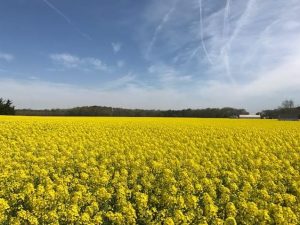Jarrod Miller, Extension Educator, Somerset County
Scattered across the Eastern Shore this spring were a few acres of golden color covering the landscape. Rather than a field of wildflowers, these may have been fields of the brassica rapeseed. Most readers will be more familiar with the edible rapeseed known as canola, a source of vegetable oil in your supermarket. Canola is more of a marketing name for consumers as it is just a lower erucic acid version of rapeseed oil.

Canola was bred in Canada to lower the content of erucic acid, which is believed to have negative health effects. In fact canola stands for “Canadian Oil, Low Acid”. The erucic acid of traditional rapeseed oil is better used as an industrial lubricant or for durable plastics. Canola was also bred to lower the content of glucosinolates, which are known to reduce livestock growth rates in rapeseed meal. The livestock meal created from canola has a high protein content, similar to soybeans. To add to the confusion in terminology, in Europe canola may be referred to as “edible” rapeseed.
Most canola is grown in upper Midwestern States such as the Dakotas. The golden color in the Mid-Atlantic is probably high erucic acid rapeseed planted for industrial uses. If you choose to include rapeseed in your rotation, benefits similar to tillage radish may be observed. However, adjustments in management will also be necessary for a productive yield.
In the Mid-Atlantic rapeseed can fit into wheat’s place in a crop rotation as a winter annual. Like wheat, there are both spring and winter annual varieties of rapeseed, with the winter variety being more productive. Rapeseed requires well drained soils and a firm seedbed with adequate moisture to germinate. It is not very tolerant of saturated soils, so fields that pond should be avoided. Rapeseed must have adequate growth prior to winter, producing 8-10 leaves before the first killing freeze. It may be best to plant following corn silage/grain for adequate time to grow, but rapeseed is also very sensitive to residual herbicides like atrazine. So you should also be aware of your herbicide program when making field decisions. When rapeseed is well established, canopy cover is excellent at restricting weed growth.

Germination and growth of rapeseed is also reduced by no-till residues during planting, poor placement in sandy soils, and crusting in clay soils. This makes management a little difficult as no-till will help soil quality in both sandy and heavy soils. Clearing residue for seed placement is necessary if you prefer no-till methods to maintain soil quality. High temperatures can kill rapeseed during early growth, and it wouldn’t be unusual to see a few warm September days on the Delmarva. During the winter leaves will often be lost, but as long as the growing point is protected, growth will return in the spring. Like tillage radish, the root system of rapeseed is also great at creating macropores for water and root movement.
Fertility requirements are also similar to wheat, although rapeseed is known to require more nitrogen, sulfur and boron. Sandy soils with low organic matter may need additional management for full productivity and a more detailed soil test would be useful. Be sure to discuss with your nutrient management advisor if you want to include rapeseed in your rotation.
Since rapeseed is a brassica it can cross pollinate with other members of the family (cabbage, broccoli, radish, ect), reducing the quality of both. In Oregon areas have been designated as either oil or vegetable production to limit cross pollination. In fact canola that cross pollinates with traditional rapeseed may end up with reduced quality and higher erucic acid contents. Due to the use of tillage radish in Maryland’s cover crop program, adjacent fields of rapeseed may not be wise. In addition it is recommended that brassicas are included in a rotation one out of every four years due to disease buildup. So any field with tillage radish as a cover crop may not be the best candidate for rapeseed the following year.
NC State Extension has worked with production in the past. They have noted (personal communication) that the small seed size is an issue if you have holes in your combines or trucks, and that temperatures in the teens have caused damage to fields in the winter.
All of the above should be considered if you choose to add rapeseed to your rotation. It may provide an alternative crop for income as well as benefit your soil health and physical quality. However, rapeseed also needs some specific management decisions to be successful.
Notes about Rapeseed:
Planting Depth: ½ to 1 inch
Row Spacing: 6-10″ irrigated or moist soil; 12-16″ dryland soils
Pesticides: Sensitive to residual herbicides like triazines from previous field crops
Pests (information from other states): Aphids, cabbage seedpod weevil, flea beetle
Disease Issues: Sclerotinia stem rot, blackleg, Alternaria black spot
References:
Herkes, J. 2014. Rapeseed and Canola for Biodiesel Production. eXtension. http://articles.extension.org/pages/26629/rapeseed-and-canola-for-biodiesel-production
University of Kentucky Extension. 2012. Canola. UK Cooperative Extension Service. https://www.uky.edu/Ag/CCD /introsheets/canola.pdf
Weber, J, R. Myers, H Minor. 1994. Canola: A Promising Oilseed. University of Missouri Extension. http://extension.missouri.edu/p/G4280
Ehrensing, D.T. 2008. Oilseed Crops: Canola. Oregon State University Extension Service. http://extension.oregonstate.edu/gilliam/sites/default/files/Canola_em8955-e.pdf
